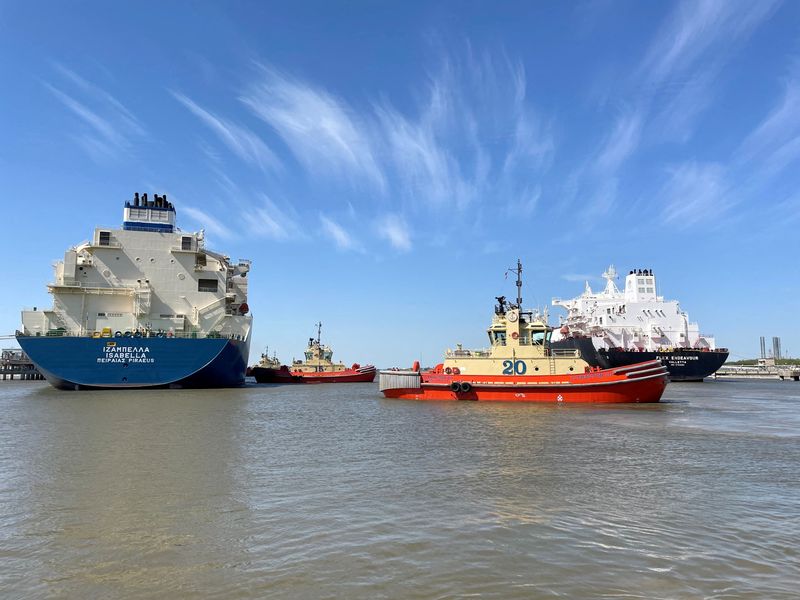By Scott DiSavino and Curtis Williams
NEW YORK/HOUSTON (Reuters) - Demand for U.S. natural gas to produce liquefied natural gas (LNG) for export this year is headed for its first decline since the country started exporting the super-chilled fuel from the lower 48 states eight years ago.
The U.S. is the world's largest exporter of the superchilled gas and a key provider of gas to Europe in the wake of Russia's invasion of Ukraine. Natural gas prices have remained relatively high in Europe as the expected U.S. growth in output in 2024 has not materialized and the continent is bracing for a new gas price shock as colder winter weather depletes stocks.
Natural gas drillers have profited from robust demand from LNG export plants especially since sanctions on Russian gas boosted European demand for U.S. LNG. Producers have indexed some output to global LNG prices, so slowing flows of gas to LNG export plants means they have less incentive to grow output.
Since 2016, when Cheniere Energy's Sabine Pass export plant in Louisiana shipped its first cargo, feedgas to the plants increased every year, even in 2020 when lockdowns during the COVID-19 pandemic slashed demand for energy.
LNG plant outages and delays in construction of new plants have reduced demand so far this year, LSEG data showed.
With just 11 days left in 2024, the amount of gas flowing to the eight big U.S. LNG export plants eased to an average of 13.0 billion cubic feet per day (bcfd) from an average of 13.1 bcfd in 2023, LSEG data showed.
One billion cubic feet of gas can supply about 5 million U.S. homes for a day.
The annual decline in demand is projected even though the first new LNG export facility since 2022, Venture Global LNG's 2.6-bcfd Plaquemines export plant in Louisiana, started producing LNG over the past week or so.
But the industry expects this year's decline to be just a blip, with U.S. LNG capacity seen more than doubling over the next four years. New plants coming online should lift capacity from around 13.8 bcfd now to 17.8 bcfd next year, 20.3 bcfd in 2026, 22.0 bcfd in 2027 and 24.2 bcfd in 2028.
PLANT OUTAGES
Among the biggest factors in this year's fall in LNG feedgas demand were numerous outages at Freeport LNG's 2.1-bcfd plant in Texas. At least one of the plant's three liquefaction trains shut every month in 2024, except October, with some of those outages lasting several weeks, according to LSEG data.
Freeport LNG is the second largest U.S. LNG producer, but Venture Global's Plaquemines will probably move into second place once it is fully operating.
Several large LNG projects under construction on the U.S. Gulf Coast have faced cost overruns due to labor shortages and supply chain challenges.
Venture Global's Plaquemines is over budget by $2.3 billion even though it has remained on schedule. The 2.4-bcfd Golden Pass plant in Texas, owned by Exxon Mobil (NYSE:XOM) and QatarEnergy, is more than $2 billion over budget and behind schedule.
Golden Pass was expected to begin producing its first LNG in 2024 but that was pushed back to late 2025 after its main contractor, Zachry Holdings, filed for bankruptcy.
Forecasts call for feedgas supplies to U.S. export facilities to rise by an average of around 2 bcfd next year, a significant step up, said Alex Munton, director of global gas and LNG research at consulting firm Rapidan Energy Group.
"We see only limited downside given tight global market conditions, with performance issues at Freeport the main risk," Munton told Reuters.
The decline is mainly because the U.S. is in between two generations of LNG build out, said Ira Joseph, an LNG market expert and senior researcher at Columbia University's Center on Global Energy Policy.
"We are bullish on U.S. LNG and generally on natural gas demand growth with strong growth going forward in the next five years," Joseph said.
Even with the decline in LNG feedgas supplies, U.S. LNG exports were expected to be up fractionally this year from 2023 due to improved efficiencies.
LNG exports were on track to rise by 1% in 2024 after jumping 12% in 2023 and an average of 43% each year during the prior five years (2018-2022), according to the U.S. Energy Information Administration's (EIA) latest Short Term Energy Outlook.
Faster growth should resume next year when new projects start. Gains could rise by around 14% to an estimated 13.7 bcfd in 2025, according to EIA.
Should you invest $2,000 in XOM right now?
With XOM making headlines, savvy investors are asking: Is it truly valued fairly? In a market full of overpriced darlings, identifying true value can be challenging. InvestingPro's advanced AI algorithms have analyzed XOM alongside thousands of other stocks to uncover hidden gems. These undervalued stocks, potentially including XOM, could offer substantial returns as the market corrects. In 2024 alone, our AI identified several undervalued stocks that later surged by 30 or more. Is XOM poised for similar growth? Don't miss the opportunity to find out.
Reveal Undervalued Stocks Now

